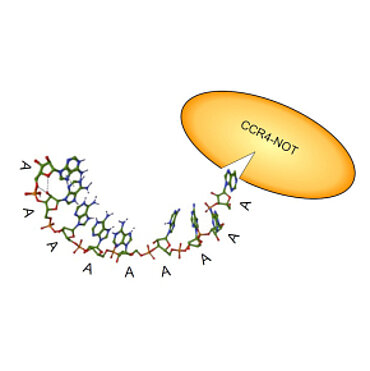Regulation of gene expression: the structure of the CCR4-NOT complex reveals a conserved protein interaction domain
The CCR4-NOT complex, conserved in all eukaryotic organisms, is a central player in gene regulation mainly through its activity of shortening the poly(A) tails of messenger RNAs which leads to their degradation. In a study published in Cell Reports, the team led by Bertrand Séraphin and his collaborators present the structure of the N-terminal module of the human CCR4-NOT complex and demonstrate that a highly conserved domain serves as a platform for interaction with new partners of interest.

Fabienne Mauxon, IGBMC
The CCR4-NOT complex is now known to regulate gene expression by controlling the shortening of the poly(A) tails of messenger RNAs (mRNAs), a process called deadenylation. This degradation is catalyzed by two subunits of the complex and induces the degradation of targeted mRNAs.
The human CCR4-NOT complex contains 8 subunits, most of which do not have nuclease activity. Some subunits facilitate the deadenylation of mRNAs that are inefficiently translated, or are associated with microRNAs or bound by destabilizing proteins. However, among the subunits of the CCR4-NOT complex, the 3D organization and role of the N-terminal module containing CNOT1, CNOT10 and CNOT11 proteins remained unknown.
In this study, the scientists succeed in shedding light on the structure of the N-terminal module of the human complex and reveal its function. They show how the proteins CNOT1, CNOT10 and CNOT11 interact. The binding site for CNOT10 is a low conserved region of CNOT11, which adopts an extended axial conformation around which CNOT10 is wrapped, and this dimer is then recognized by CNOT1. In this configuration, the highly conserved domain of CNOT11 folds as an independent entity that can be seen as an "antenna". The authors show that this serves as an interaction for new partners of the CCR4-NOT complex. Among others, they identified GGNBP2 as a partner of this domain and determined its interaction mode with CNOT11. GGNBP2 has been associated with various pathologies in humans and its inactivation in mice leads to sterility in male individuals by blocking sperm formation.
These observations allow a better understanding of the organization of the CCR4-NOT complex and facilitate future studies of the structure of this whole assembly. They also reveal the presence of an unexpected "antenna" and its interactions with partners that will help to better understand the role of the CCR4-NOT complex in differentiation, development and certain pathologies.
The CCR4-NOT complex plays a major role in the regulation of gene expression by initiating the degradation of messenger RNAs through the shortening of their poly(A) tail. Resolution of the 3D structure of the N-terminal module of this complex, consisting of CNOT1, CNOT10 and CNOT11 proteins, reveals the existence of a conserved antenna that allows the recruitment of new factors. One of the factors recruited is the GGNBP2 protein which is associated with human pathologies and plays a role in development and spermatogenesis.
